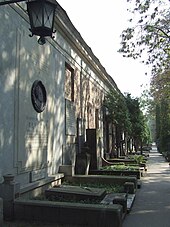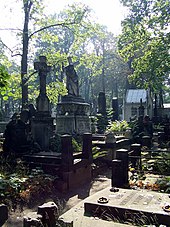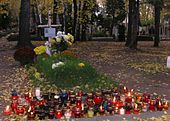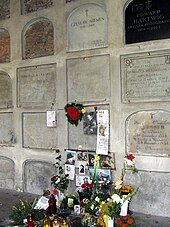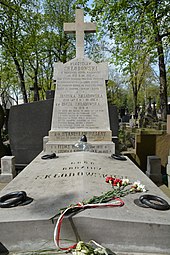Powązki cemetery
The Powązki Cemetery ( Polish : Cmentarz Powązkowski ) is the most famous and historically most important municipal cemetery in the Polish capital, Warsaw . It is a resource for sculpture and small architecture.
There are several cemeteries in the Powązki district of Warsaw:
- The old Roman Catholic Powązki cemetery with the Karl Borromeo Church.
- The Jewish cemetery on Okopowa Street
- The Tatar-Islamic Cemetery at the end of Tatarska Street
- The Caucasian Islamic Cemetery on Obozowa / Młynarska Street
- The Evangelical Augsburg cemetery on Młynarska Street with the Halpern Chapel
- The Evangelical Reformed Cemetery on Młynarska Street and Żytnia Street
and 1 km to the northwest:
- The military / municipal cemetery on Powązkowska Street with the graves of the victims of the Warsaw Uprising .
history
The old, Roman Catholic Powązki cemetery is located in the western part of Wola and is 43 hectares in size. Its origins go back to 1790. At that time, other cemeteries in the center of Warsaw were closed for sanitary reasons. The Starost Melchior Korwin Szymanowski made 2.6 hectares available for the complex, on May 20, 1792 the cemetery was consecrated and in 1793 the construction of the Saint Borromeo Church was completed, founded by King Stanislaus August and Prince Primate Michael Poniatowski, who was the architect Dominik Merlini .
The cemetery has been expanded 19 times in the course of its history, the last time to its present size in 1971. It is administered by the church and houses around 2.5 million mostly Catholic burial sites. The other denominations, u. a. Lutherans , Calvinists , Jews and Tatars have their own cemeteries in the same complex.
One of the most important extensions was the establishment of the military cemetery in 1912, referred to as the municipal cemetery during the era of the People's Republic and some time afterwards. After Poland regained independence in 1918, it became a state necropolis , where many of the most famous Poles are buried, regardless of their religious affiliation , many of them in Aleja Zasłużonych , the avenue of the deserving.
In the Second World War , the cemetery suffered damage as the church, some of the graves is still in ruins. The Home Army ( Armia Krajowa ) was also active on the site because of the many shelter options , also for supplying the Warsaw Ghetto .
A large part of the remote military / municipal cemetery is occupied by the graves of victims of the Warsaw Uprising . In many cases the names remained unknown and the graves only bear an identification number from the Polish Red Cross . There are also some burial grounds for members of various branches of arms and military units, as well as mass graves of civilian victims.
Every November 1st, All Saints' Day , as in all Polish cemeteries, vigils are held and candles are placed on the graves. Since 1974, donations have been collected on November 1st and 2nd for the renovation of valuable tombs. Well-known actors, writers and journalists act as fundraisers. At the same time, donations are being collected for the rescue of the Polish Łyczakowski cemetery in what is now Lemberg , Ukraine . The fundraising campaign was initiated by the music critic Jerzy Waldorff (1910–1999). His tomb is next to the old catacombs.
Gravesites
selected personalities:
- Jerzy Andrzejewski (1909–1983), poet and publicist
- Krzysztof Kamil Baczyński (1921–1944), poet
- Tekla Bądarzewska (1834–1861), composer
- Tadeusz Baird (1928–1981), composer
- Aleksander Bardini (1913–1995), actor and director
- Miron Białoszewski (1922–1983), playwright and actor
- Hanka Bielicka (1915–2006), actress, cabaret artist
- Bolesław Bierut (1892–1956), politician
- Stefan Bryła (1886–1943), civil engineer
- Jan Czekanowski (1882–1965), anthropologist, ethnologist and Africa researcher
- Lucyna Ćwierczakiewiczowa (1829–1901), cookbook author, journalist
- Maria Dąbrowska (1889–1965), poet
- Mariusz Dmochowski (1930–1992), actor
- Stanisław Dygat (1914–1978), writer
- Joseph Xaver Elsner (1769–1854), composer and conductor
- Aleksander Gieysztor (1916–1999), historian
- Agaton Giller (1831–1887), historian, publicist, resistance fighter
- Wieńczysław Gliński (1921–2008), actor
- Władysław Gomułka (1905–1982), politician
- Józef Gosławski (1908–1963), sculptor and medalist
- Władysław Grabski (1874–1938), politician, historian, prime minister
- Bronisław Geremek (1932–2008), politician, historian, foreign minister
- Zbigniew Herbert (1924–1998), writer
- Marek Hłasko (1934–1969), writer
- Jerzy Hryniewiecki (1908–1989), architect
- Karol Irzykowski (1873–1944), writer, literary critic
- Tadeusz Janczar (1926–1997), actor
- Wojciech Jaruzelski (1923–2014), head of state of Poland from 1985 to 1990
- Kalina Jędrusik (1930–1991), singer and actress
- Jacek Kaczmarski (1957-2004), poet and singer
- Esther Rachel Kamińska (1870–1925), actress
- Mieczysław Karłowicz (1876–1909), composer
- Felicjan Kępiński (1885–1966), astronomer
- Augustus Graf Kicki z Kitek h. Gozdawa (1754-1824), senator, Polish nobleman
- Jan Kiepura (1902–1966), singer and actor
- Krzysztof Kieślowski (1941–1996), film director
- Jan Kiliński (1760-1819), commander of the Kościuszko uprising
- Hugo Kołłątaj (1750–1812), politician and philosopher
- Krzysztof Komeda (1931–1969), jazz composer
- Tadeusz Komorowski , called "Bór" (1895–1966), Commander of the Home Army
- Stanisław Konarski (1700–1773), writer, educator, school reformer
- Ryszard Kukliński (1930–2004), master spy in the Cold War
- Jacek Kuroń (1934–2004), dissident, Solidarność leader
- Henryk Leliwa-Roycewicz (1898–1990), eventing rider and Olympian
- Jan Lebenstein (1930–1999), painter
- Józef Grzegorz Lessel (1802–1844), architect
- Samuel Bogumił Linde (1771–1847), lexicologist and polonist
- Tadeusz Łomnicki (1927–1992), actor
- Jadwiga Łuszczewska (1834–1908), writer
- Witold Lutosławski (1913–1994), composer
- Witold Małcużyński (1914–1977), pianist
- Stefan Meller (1942–2008), historian and diplomat
- Dominik Merlini (1730-1797), architect, laid the Łazienki Park on
- Stanisław Moniuszko (1819–1872), composer
- Andrzej Munk (1921–1961), director and cameraman
- Tadeusz Nalepa (1943–2007), composer and singer
- Czesław Niemen (1939–2004), singer and composer
- Jan Nowak-Jeziorański (1914–2005), politician, publicist, director of Radio Free Europe
- Michał Kazimierz Ogiński (1731–1799), magnate, hetman of Greater Lithuania
- Michał Kleofas Ogiński (1765–1833), composer, politician
- Leopold Okulicki (1898–1946), pseud. "Niedźwiadek", last commander of the Home Army
- Kazimierz Opaliński (1890–1979), actor and director
- Agnieszka Osiecka (1936–1997), poet, also of song lyrics
- Jan Parandowski (1895–1978), writer
- Tadeusz Pełczyński (1892–1985), general and secret service officer
- Bolesław Piasecki (1915–1979), officer, politician
- Witold Pilecki (1901–1948), freedom fighter
- Piotr Potworowski (1898–1962), painter and graphic artist
- Bolesław Prus (1847–1912), writer
- Kazimierz Pużak (1883–1950), member of the PPS
- Adam Rapacki (1909–1970), diplomat, Foreign Minister 1956–1968
- Marian Rejewski (1905–1980), famous cryptanalyst , deciphered the ENIGMA encryption
- Władysław Reymont (1867–1925), Nobel Prize for Literature
- Wacław Rolicz songs (1866–1912), poet
- Stefan Rowecki , pseud. "Grot" (1895–1944), Commander of the Home Army
- Wojciech Rubinowicz (1889–1974), physicist
- Edward Rydz-Śmigły (1886–1941), Marshal and Head of State 1935–1939
- Leon Schiller (1887–1954), writer, literary critic, theater theorist
- Irena Sendler (1910–2008), head of the Żegota children's department
- Henryk Siemiradzki (1843–1902), painter
- Wacław Sierpiński (1882–1969), mathematician
- Władysław Skłodowski (1832–1902), translator, father of Marie Skłodowska Curie
- Kamila Skolimowska (1982–2009), hammer thrower, Olympic champion
- Marian Smoluchowski (1872–1917), physicist
- Stanisław Sosabowski (1892–1967), General
- Leopold Staff (1878–1957), poet
- Jerzy Stempowski (1894–1969), essayist, writer
- Józef Szajna (1922–2008), actor and theater director
- Władysław Szpilman (1911-2000), pianist
- Sławomir Szwedowski (1928–2000), economist
- Aleksander Szczygło (1963-2010), politician
- Adolf Szyszko-Bohusz (1883–1948), architect and university professor
- Karol Świerczewski (1897–1947), general and communist war hero
- Wacław Święcicki (1848–1900), politician and poet of the Warschavjanka
- Wojciech Świętosławski (1881–1968), biophysicist
- Franciszek Szymczyk (1892–1976), chemist, cyclist and Olympian
- Julian Tuwim (1894–1953), poet
- Violetta Villas (1938–2011) singer and actress
- Henryk Wieniawski (1835–1880), composer
- Stanisław Wojciechowski (1869–1953), President of Poland
- Kazimierz Władysław Wójcicki (1807–1879), writer
- Maria Zachwatowicz (1902–1994), architect
- Wiktor Zin (1925–2007), architect and draftsman
- Stefan Żeromski (1864–1925), writer
- Narcyza Żmichowska , pseud. "Gabryella" (1819–1876), poet, champion of feminism
Web links
Coordinates: 52 ° 15 ′ 3 ″ N , 20 ° 58 ′ 14 ″ E


